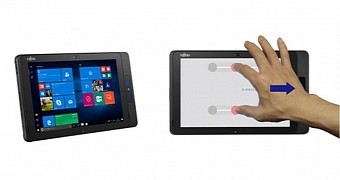Fingerprint sensors appear to be so yesterday, with most manufacturers now looking into alternative authentication methods that can’t be bypassed and which provide enhanced security to users.
While Microsoft, Samsung, and even Apple are looking into face and iris recognition, Fujitsu has decided to look somewhere else, and the company just launched a tablet featuring palm vein authentication.
While this might sound unusual at first (and it kind of does given that it’s the first device in the world that requires you to scan your veins before letting you get to the desktop), Fujitsu says that the so-called Arrows Tab Q507/P-SP 10.1-inch Windows 10 tablet is just the first in a longer series of devices featuring such technology.
Water and dust resistance too
The biggest challenge was to fit the technology into such a small device, Fujitsu says, mostly because the device is so thin and needs to be able to accurately scan the owner’s palm.
And it looks like the project is successful, as the display lights up and highlights a specific area on the screen where the user needs to slide the palm to have their veins scanned for authentication purposes.
Fujitsu explains that during the scan, the complete pattern of a palm’s veins is captured using slices that are generated as the hand passes over the optical unit, and each slice is then compared to the ones created when the owner enrolled a specific user to grant access.
Aside from this revolutionary technology, the tablet isn’t exactly a top product, though it also features water and dust resistance. Sales will begin in August this year, with pricing to start at approximately $780, but more information in this regard will be released at a later time.
You can find out more about how the new vein scanning system works by reading the release below, with Fujitsu saying that it can incorporate the same feature on a wider array of devices, not just tablets.

 14 DAY TRIAL //
14 DAY TRIAL //